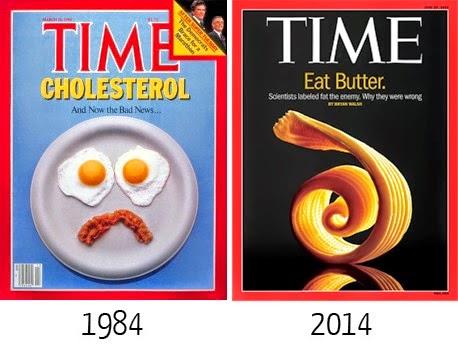
The last post covered the sugar industry”™s push to demonize fats and take the heat off sugar. Unfortunately, it was successful. Here”™s what happened next.
Recommendations for increased carbs came from everywhere -- including the 1991 Food Guide Pyramid. The bottom tier called for 6 to 11 servings of grains.
The Pritikin Wellness Center suggested diets of 7% protein and under 10% fat, leaving 83% or more in carbs.
My clients”™ food logs showed that the carbs they ate instead of fats and proteins were not vegetables, legumes, or root vegetables, but sugars and refined-flour products.
During the low-fat craze, consumption of sugar soared. From 1984 to 1997, the increase in sugar consumption — not total consumption, just the increase during those 13 years — was 25 pounds per person per year.
This increase may have been due partly to a phenomenon known as the sugar/fat seesaw: as one drops in the diet, the other goes up. When everyone went low-fat, the decrease in fat intake was met by a huge increase in sugar.
The sugar/fat seesaw is acknowledged in science journals but not explained. In my 1999 dissertation, I outlined a hormonal and neurochemical explanation for it.
During the low-fat craze, consumption of artificial sweeteners and high-fructose corn syrup rose, based on USDA figures. In 1996, the Nutrition Action HealthLetter reported that US sugar consumption had risen again for the 10th consecutive year.
In addition — and it didn”™t surprise me — obesity in the US became epidemic. The CDC reported that, after 20 years at 25% of the population, the number of overweight Americans increased to 33% in the 1980s. Investigators from the Minnesota Heart Health Program couldn”™t explain the increase with data on dietary fat.
But they hadn”™t yet realized that they should investigate sugar. As in the 1970s.
Clearly, increased sugar consumption benefited the sugar industry. The obesity epidemic was an unfortunate consequence of their profit-grabbing strategies.
Low Fat Fitness Pros See the Light
At first, the fitness industry jumped on the low-fat train, and I got trapped on it. Throughout the industry, weight-loss guidelines for clients reflected the low-fat dogma. At fitness conferences, attendee goody bags were filled with low-fat, high-sugar “energy bars” and more.
In the early 1990s, I made a presentation to fitness professionals on health problems associated with sugar intake. An angry woman stood up and shouted, “I have the same degree you do” — we both had master”™s degrees in exercise physiology — “and you don”™t know what you”™re talking about!”
In 1995, I was invited to a fitness conference to participate in a panel discussion called “To Eat Carbs or Not To Eat Carbs”. The ‘panel”™ included two people: a Pritikin Center researcher and me. It was structured as a debate — and someone definitely wanted me to lose.
I was kept in the dark about things, but the Pritikin guy was in on the plot. He was also positioned to speak second so he could challenge my words with his low-fat Pritikin rhetoric.
Toward the late 1990s, a controversy raged. The fitness industry began to reflect some of the controversy. We saw fitness industry publications that warned against carb intake, followed closely by articles promoting “carb loading” prior to athletic events.
Only a few years after its 1995 pro-sugar supplement, the AJCN devoted an entire 1998 supplement to the role of fats and oils in the fight against obesity and metabolic complications. Several articles in it addressed the failure of low-fat diets to effect long-term weight reduction.
Now we”™ve come full circle. People are finally realizing the many ways sugar and high-sugar foods impact our health — diabetes, high blood pressure, mood swings, out-of-control eating, and more.
Bonus Tip: Stay Aware, Cautious and Skeptical
Because more people know more about nutrition now than at any other time I can recall, I don”™t think the sugar industry will be able to bamboozle us with talk of the dangers of fats. Too much recent research has shown the benefits of certain fats — and the relative harmlessness of the ones we were always told were bad.
Will the sugar industry give up? Don”™t count on it. I fully expect to see a push for the benefits of “sneaky sugars,” the ones that people want to believe are good for them because they offer an excuse to eat sugar.
Those sneaky sugars will include products sweetened with “natural” fruit juice. Or the agave syrup we see everywhere these days. And probably new ones we haven”™t seen yet. Are they — will they be — good for you? Please believe me when I say “No!”
What we”™re told about nutrition in the US is often not what we should know or do, but what will benefit the various food industries.
Sugar sneaks into our foods and our meals in many ways. It can affect health, inflammation, metabolism, appetite, and moods. It can cause cravings and binge eating. It can affect autistic kids, as well as pregnant women and their babies.
Fructose is arguably the worst form of sugar — there are serious issues with it! Yet people are more reluctant to give up fruit than ever before — it”™s the preferred form of sugar for people who want to believe their diets are healthy.
I”™ve written book chapters on fruit as the “final frontier” in nutrition health. And it may be.
- New Year’s Resolutions: A Sugar Addict’s Survival Guide - April 15, 2024
- Motivation vs. Enthusiasm - October 12, 2023
- Why Exercise Shouldn’t Be Just One Thing - November 9, 2022
